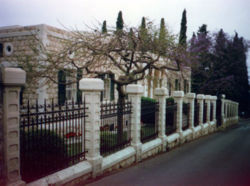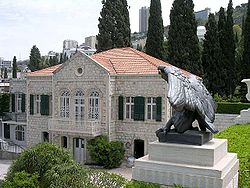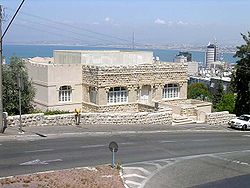
Pilgrim House
Encyclopedia
The term Pilgrim House is a term used by Bahá'í
s to signify buildings where pilgrims are (or were) greeted and housed during pilgrimage
to the Bahá'í holy places.
There have been numerous buildings within Haifa
, Israel
dedicated to this, including 4 Haparsim Street (the original Western Pilgrim House), 10 Haparsim Street (the second Western Pilgrim House), the Haifa Pilgrim House (also known as the Eastern Pilgrim House), and the Pilgrim Reception Centre.
Another pilgrim house is located at Bahjí, near the Shrine of Bahá'u'lláh
.
, Israel
, was used a Pilgrim House for members of the Bahá'í Faith
of Western origin who had come for pilgrimage during the early years of the 20th century, before it was replaced by 10 Haparsim Street.
The house is currently part of the Bahá'í World Centre
. While it was originally rented to serve as a Pilgrim House, the house was then bought by `Abdu'l-Bahá
. After being replaced by new Western Pilgrim House, the site was then used by members of the Bahá'í holy family. It left Bahá'í hands shortly before being re-bought by the Universal House of Justice
.
It was at 4 Haparsim Street that Shoghi Effendi
gave Mary Maxwell, who he would later marry, the title Amatu'l-Bahá Rúhíyyih Khanum. It is now a pilgrimage
site for Bahá'ís.
 The second Western Pilgrim House, often referred to as "the old western pilgrim house", located at 10 Haparsim Street in Haifa, Israel, was used a Pilgrim House for members of the Bahá'í Faith who had come for pilgrimage during the first half of the 20th century. It is currently part of the Bahá'í World Centre
The second Western Pilgrim House, often referred to as "the old western pilgrim house", located at 10 Haparsim Street in Haifa, Israel, was used a Pilgrim House for members of the Bahá'í Faith who had come for pilgrimage during the first half of the 20th century. It is currently part of the Bahá'í World Centre
and used by the Bahá'í International Community Secretariat and related offices.
The house was originally paid for by Amelia Collins
, a wealthy American Bahá'í, who felt the facilities of the previous Westerner's pilgrim house at 4 Haparsim were inadequate. Its construction was started under the instruction of `Abdu'l-Bahá
, but was only completed during the time that Shoghi Effendi
was the Guardian of the Bahá'í Faith. Although it served originally as the Pilgrim house for the westerners, it has been used for other purposes more recently:
As of 2005, it is currently included in the pilgrimage run by the Bahá'í World Centre
 The Eastern Pilgrim House or the "Haifa Pilgrim House" is a Pilgrim House for Bahá'ís when they go on pilgrimage. The house was built after `Abdu'l-Bahá
The Eastern Pilgrim House or the "Haifa Pilgrim House" is a Pilgrim House for Bahá'ís when they go on pilgrimage. The house was built after `Abdu'l-Bahá
interred the remains of the Báb
on Mount Carmel. The construction of this stone building was supervised Mírzá Ja’far Rahmání of 'Ishqábád, who also paid all the expenses. It is known as the "Eastern Pilgrim House", as for decades it housed the Persian
pilgrims. After 1951, when the Western Pilgrim House at 10 Haparsim Street became the seat of the International Bahá'í Council
, it became the Pilgrim House for all pilgrims. In 1969 the decision was taken to accommodate pilgrims in hotels, so that the Pilgrim House could be converted into a pilgrim centre.
 The Pilgrim Reception Centre or the "Haifa Pilgrim Reception Centre" is the newest Pilgrim Reception Centre for pilgrimage to sites near the Bahá'í World Centre. It is composed of two conjoined buildings, of a historic medical clinic, that have recently been remodeled. In October 2000 this new Reception Centre, which can accommodate up to 500 people, opened.http://news.bahai.org/story/67
The Pilgrim Reception Centre or the "Haifa Pilgrim Reception Centre" is the newest Pilgrim Reception Centre for pilgrimage to sites near the Bahá'í World Centre. It is composed of two conjoined buildings, of a historic medical clinic, that have recently been remodeled. In October 2000 this new Reception Centre, which can accommodate up to 500 people, opened.http://news.bahai.org/story/67
Bahá'í Faith
The Bahá'í Faith is a monotheistic religion founded by Bahá'u'lláh in 19th-century Persia, emphasizing the spiritual unity of all humankind. There are an estimated five to six million Bahá'ís around the world in more than 200 countries and territories....
s to signify buildings where pilgrims are (or were) greeted and housed during pilgrimage
Bahá'í pilgrimage
A Bahá'í pilgrimage currently consists of visiting the holy places in Haifa, Akká, and Bahjí at the Bahá'í World Centre in Northwest Israel. Bahá'ís do not have access to other places designated as sites for pilgrimage....
to the Bahá'í holy places.
There have been numerous buildings within Haifa
Haifa
Haifa is the largest city in northern Israel, and the third-largest city in the country, with a population of over 268,000. Another 300,000 people live in towns directly adjacent to the city including the cities of the Krayot, as well as, Tirat Carmel, Daliyat al-Karmel and Nesher...
, Israel
Israel
The State of Israel is a parliamentary republic located in the Middle East, along the eastern shore of the Mediterranean Sea...
dedicated to this, including 4 Haparsim Street (the original Western Pilgrim House), 10 Haparsim Street (the second Western Pilgrim House), the Haifa Pilgrim House (also known as the Eastern Pilgrim House), and the Pilgrim Reception Centre.
Another pilgrim house is located at Bahjí, near the Shrine of Bahá'u'lláh
Shrine of Bahá'u'lláh
The Shrine of Bahá'u'lláh, located in Bahjí near Acre, Israel, is the most holy place for Bahá'ís and represents their Qiblih, or direction of prayer...
.
Original Western Pilgrim House
The original Western Pilgrim House, located at 4 Haparsim Street in HaifaHaifa
Haifa is the largest city in northern Israel, and the third-largest city in the country, with a population of over 268,000. Another 300,000 people live in towns directly adjacent to the city including the cities of the Krayot, as well as, Tirat Carmel, Daliyat al-Karmel and Nesher...
, Israel
Israel
The State of Israel is a parliamentary republic located in the Middle East, along the eastern shore of the Mediterranean Sea...
, was used a Pilgrim House for members of the Bahá'í Faith
Bahá'í Faith
The Bahá'í Faith is a monotheistic religion founded by Bahá'u'lláh in 19th-century Persia, emphasizing the spiritual unity of all humankind. There are an estimated five to six million Bahá'ís around the world in more than 200 countries and territories....
of Western origin who had come for pilgrimage during the early years of the 20th century, before it was replaced by 10 Haparsim Street.
The house is currently part of the Bahá'í World Centre
Bahá'í World Centre
The Bahá'í World Centre is the name given to the spiritual and administrative centre of the Bahá'í Faith. The World Centre consists of the Shrine of Bahá'u'lláh near Acre, Israel, the Shrine of the Báb and its gardens on Mount Carmel in Haifa, Israel, and various other buildings in the area...
. While it was originally rented to serve as a Pilgrim House, the house was then bought by `Abdu'l-Bahá
`Abdu'l-Bahá
‘Abdu’l-Bahá , born ‘Abbás Effendí, was the eldest son of Bahá'u'lláh, the founder of the Bahá'í Faith. In 1892, `Abdu'l-Bahá was appointed in his father's will to be his successor and head of the Bahá'í Faith. `Abdu'l-Bahá was born in Tehran to an aristocratic family of the realm...
. After being replaced by new Western Pilgrim House, the site was then used by members of the Bahá'í holy family. It left Bahá'í hands shortly before being re-bought by the Universal House of Justice
Universal House of Justice
The Universal House of Justice is the supreme governing institution of the Bahá'í Faith. It is a legislative institution with the authority to supplement and apply the laws of Bahá'u'lláh, the founder of the Bahá'í Faith, and exercises a judicial function as the highest appellate institution in the...
.
It was at 4 Haparsim Street that Shoghi Effendi
Shoghi Effendi
Shoghí Effendí Rabbání , better known as Shoghi Effendi, was the Guardian and appointed head of the Bahá'í Faith from 1921 until his death in 1957...
gave Mary Maxwell, who he would later marry, the title Amatu'l-Bahá Rúhíyyih Khanum. It is now a pilgrimage
Bahá'í pilgrimage
A Bahá'í pilgrimage currently consists of visiting the holy places in Haifa, Akká, and Bahjí at the Bahá'í World Centre in Northwest Israel. Bahá'ís do not have access to other places designated as sites for pilgrimage....
site for Bahá'ís.
Second Western Pilgrim House

Bahá'í World Centre
The Bahá'í World Centre is the name given to the spiritual and administrative centre of the Bahá'í Faith. The World Centre consists of the Shrine of Bahá'u'lláh near Acre, Israel, the Shrine of the Báb and its gardens on Mount Carmel in Haifa, Israel, and various other buildings in the area...
and used by the Bahá'í International Community Secretariat and related offices.
The house was originally paid for by Amelia Collins
Amelia Collins
Amelia Engelder Collins was a prominent American Bahá'í from the Lutheran family. She became Bahá'í in 1919. She made large donations to several Bahá'í projects in Haifa, Israel, like the building of the Western Pilgrim House, the superstructure of the Shrine of the Báb the International Archives...
, a wealthy American Bahá'í, who felt the facilities of the previous Westerner's pilgrim house at 4 Haparsim were inadequate. Its construction was started under the instruction of `Abdu'l-Bahá
`Abdu'l-Bahá
‘Abdu’l-Bahá , born ‘Abbás Effendí, was the eldest son of Bahá'u'lláh, the founder of the Bahá'í Faith. In 1892, `Abdu'l-Bahá was appointed in his father's will to be his successor and head of the Bahá'í Faith. `Abdu'l-Bahá was born in Tehran to an aristocratic family of the realm...
, but was only completed during the time that Shoghi Effendi
Shoghi Effendi
Shoghí Effendí Rabbání , better known as Shoghi Effendi, was the Guardian and appointed head of the Bahá'í Faith from 1921 until his death in 1957...
was the Guardian of the Bahá'í Faith. Although it served originally as the Pilgrim house for the westerners, it has been used for other purposes more recently:
- From 1951 to 1963 it housed the International Bahá'í CouncilInternational Bahá'í CouncilThe International Bahá'í Council was an administrative institution of the Bahá'í Faith, first created in 1951 as a precursor to the Universal House of Justice, which replaced it in 1963.-Formation:...
- From 1963 to 1983 it served as the Seat of the Universal House of JusticeUniversal House of JusticeThe Universal House of Justice is the supreme governing institution of the Bahá'í Faith. It is a legislative institution with the authority to supplement and apply the laws of Bahá'u'lláh, the founder of the Bahá'í Faith, and exercises a judicial function as the highest appellate institution in the...
- From 1983 to 2000 it was occupied by the International Teaching CentreInternational Teaching CentreThe International Teaching Centre is a Bahá'í institution based in the Bahá'í World Centre in Haifa, Israel...
As of 2005, it is currently included in the pilgrimage run by the Bahá'í World Centre
Eastern Pilgrim House

`Abdu'l-Bahá
‘Abdu’l-Bahá , born ‘Abbás Effendí, was the eldest son of Bahá'u'lláh, the founder of the Bahá'í Faith. In 1892, `Abdu'l-Bahá was appointed in his father's will to be his successor and head of the Bahá'í Faith. `Abdu'l-Bahá was born in Tehran to an aristocratic family of the realm...
interred the remains of the Báb
Báb
Siyyid `Alí Muḥammad Shírází was the founder of Bábism, and one of three central figures of the Bahá'í Faith. He was a merchant from Shíráz, Persia, who at the age of twenty-four claimed to be the promised Qá'im . After his declaration he took the title of Báb meaning "Gate"...
on Mount Carmel. The construction of this stone building was supervised Mírzá Ja’far Rahmání of 'Ishqábád, who also paid all the expenses. It is known as the "Eastern Pilgrim House", as for decades it housed the Persian
Persian people
The Persian people are part of the Iranian peoples who speak the modern Persian language and closely akin Iranian dialects and languages. The origin of the ethnic Iranian/Persian peoples are traced to the Ancient Iranian peoples, who were part of the ancient Indo-Iranians and themselves part of...
pilgrims. After 1951, when the Western Pilgrim House at 10 Haparsim Street became the seat of the International Bahá'í Council
International Bahá'í Council
The International Bahá'í Council was an administrative institution of the Bahá'í Faith, first created in 1951 as a precursor to the Universal House of Justice, which replaced it in 1963.-Formation:...
, it became the Pilgrim House for all pilgrims. In 1969 the decision was taken to accommodate pilgrims in hotels, so that the Pilgrim House could be converted into a pilgrim centre.
Pilgrim Reception Centre

Reason for separate Western and Eastern Pilgrim Houses
The reasons for having separate Pilgrim Houses for the Western and Eastern Bahá'ís are due to the different cultures of the pilgrim's backgrounds. Examples may include:- Eastern pilgrims would always remove their shoes before entering any building whereas westerners may not.
- Eastern pilgrims gave a special reverence to `Abdu'l-Bahá`Abdu'l-Bahá‘Abdu’l-Bahá , born ‘Abbás Effendí, was the eldest son of Bahá'u'lláh, the founder of the Bahá'í Faith. In 1892, `Abdu'l-Bahá was appointed in his father's will to be his successor and head of the Bahá'í Faith. `Abdu'l-Bahá was born in Tehran to an aristocratic family of the realm...
whereas westerners did not always understand this. - The role of women was very different at the turn of the century in the two cultures.

